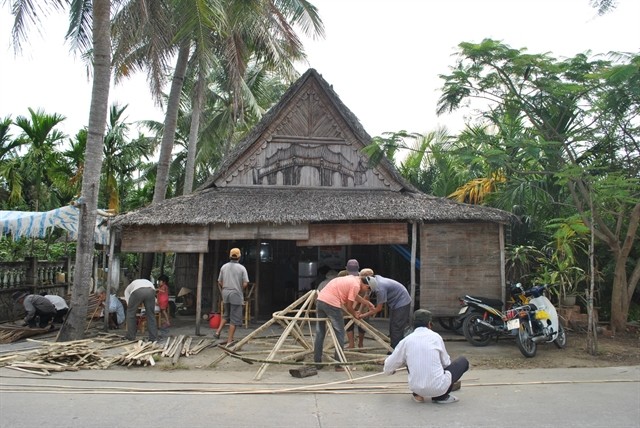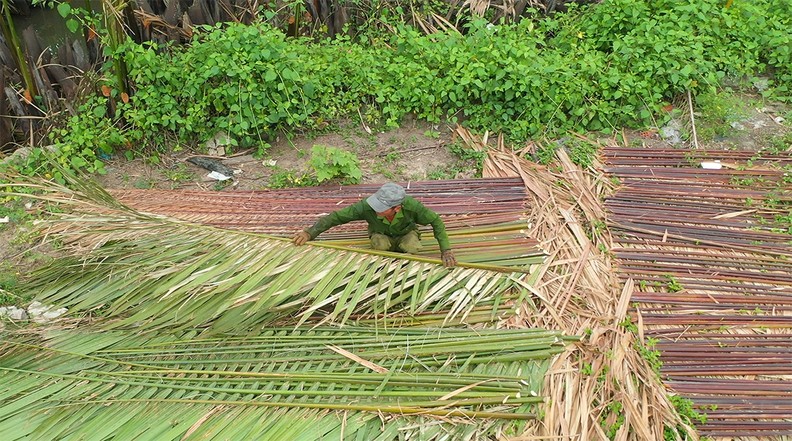The craft of building bamboo-and-nipa palm houses in Cam Thanh Commune, Hoi An City, in the central province of Quang Nam, has recently been recognised as national intangible cultural heritage. The acknowledgement not only brings joy and pride to the local people but also generates motivation to preserve and promote the value of cultural heritage in the locality.

A house made from bamboo poles and nipa palm leaves and stalks in Hoi An City. (Photo courtesy of the Hoi An Centre for Cultural Heritage Management and Preservation)
The craft of making houses with materials from bamboo and nipa palm trees is a distinctive practice that contributes to attracting tourists and promoting the image of Hoi An City, as well as Quang Nam Province in general, to both domestic and international visitors.
Located downstream of Thu Bon River, Cam Thanh Commune is located on a peninsula surrounded by rivers on all of its four sides. The coastal location and unique climate create favourable conditions for nipa palm trees to grow and stay green all year round.
According to historical documents currently archived at the Hoi An Centre for Cultural Heritage Management and Preservation, the nipa palm trees appeared in Cam Thanh Commune at the beginning of the 18th century. It is believed that they originated from the southern provinces, with the locals having brought this plant while conducting trading activities by ships on rivers and seas.
Utilising natural materials along with the creativity and ingenuity of the craftsmen, the profession of making houses with bamboo and nipa palm trees was formed and developed in Cam Thanh Commune.
The cost of making a house from bamboo and nipa materials is cheap and the house can last for up to 15-20 years. This form of environmentally and wallet-friendly housing provides coolness in summer and warmth in winter. It is also clean and dry despite the salty coastal climate.
Tran Bua, an 84-year-old man from Thanh Tam Village, Cam Thanh Commune, said that he began learning the craft of making bamboo and nipa houses from his grandfather at the age of 12. He is now handing down the profession to his own children and grandchildren along with other young people in the village.

Nipa palms must be harvested in March or August, then they are soaked in water and left to dry. (Photo: VNA)
The craft of making houses with bamboo and nipa palm has also practiced in neighbouring areas such as Cam Chau, Cam Nam, and Cam Kim.
To create this type of house, craftsmen must go through multiple complex stages, from collecting the necessary materials to processing and crafting them into a complete building.
Although many stages can be supported by machines, the making process also requires the experience and techniques of the craftsmen.
For example, nipa palms must be harvested in March or August, then they are soaked in water and left to dry. Bamboo is usually purchased in mountainous districts and then transported to Cam Thanh by river.
However, as the living standards of the local people have improved, their preferences have shifted to new building materials which are more durable, leading to a decline in the demand for bamboo and nipa palm-made houses.
In recent years, together with the tourism growth of Hoi An, there is a growing demand for restoring and building traditional houses using bamboo and nipa palm materials.
The development of green and eco-tourism has also provided an opportunity for the craft to revive, with many resorts, hotels, restaurants, and souvenir shops in Hoi An now prioritising environmentally friendly and indigenous materials.

Visitors attend a class on making handicrafts from bamboo and nipa palm.
Beside using bamboo to build houses, local craftsmen also create many handicrafts and furniture products such as baskets, shelves, chairs, bowls, cups, straws, and children's toys, which are highly appreciated by customers thanks for their high-quality and Vietnamese cultural identity.
Currently, Cam Thanh has nearly 200 skilled workers who earn their living from the craft. Some workshops processing and producing materials from bamboo and nipa palms in the commune have become attractive tourist destinations, such as those owned by Vo Tan Tan and Truong Tan Tho.
What these artisans have in common is that they were born and raised in Cam Thanh and have inherited the craft as well as the enthusiasm for this profession from their ancestors.
The recognition of the craft of making bamboo and nipa palm houses in Cam Thanh Commune as a national intangible cultural heritage is an important milestone in identifying and upholding the traditional cultural values of the local community.
Accordingly, in recent years, the People's Committee of Cam Thanh Commune has called on residents to participate in the project to preserve the Cam Thanh nipa palm forest in order to increase the planting area, which helps facilitate tourism development while creating a sustainable source of raw materials for the traditional craft of making bamboo and nipa palm houses.
During boat tours to the Cam Thanh nipa palm forest, visitors are also given instruction on how to make some simple items from nipa palm leaves such as hats, rings, bracelets, and toys.
The recognition of the craft of making bamboo and nipa palm houses in Cam Thanh Commune as a national intangible cultural heritage is an important milestone in identifying and upholding the traditional cultural values of the local community.
It also enriches the natural and cultural resource of Hoi An City, which recently joined the UNESCO Creative Cities Network (UCCN) in the Crafts and Folk Art category in November 2023.
My Hanh - Translated by NDO